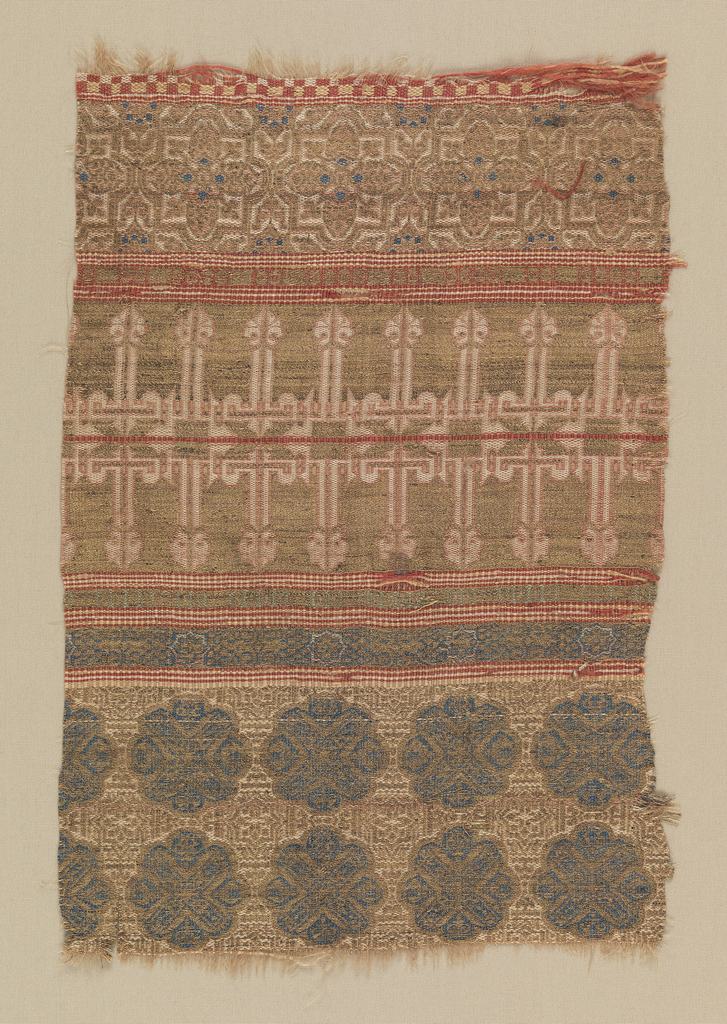This Spanish textile displays the intricate geometric design which permeates many forms of Islamic art and represents the type of rich textiles favored by the Christian royalty of Iberia. This fragment is a piece of a mantle discovered in the tomb of the Infante Don Felipe of Castile (1231-1274) at the church of Santa María la Blanca in Villalcázar de Sirga, Palencia.[1] Felipe led a noble rebellion against his brother Alfonso X, king of Castile, and eventually, he and the other rebels renounced their feudal ties and found asylum in the Nasrid Kingdom of Granada.[2] Felipe may have acquired this fine cloth while residing in Granada, an area where the silk industry flourished.[3] Several other pieces of this mantle are preserved in other museum collections: the Museo Arqueológico Nacional in Madrid (51016), the Victoria & Albert Museum (796-1893), and the Art Institute of Chicago (1950.1150).[4] Other fragments with a similar pattern from this tomb, possibly parts of a tunic, appear in various museum collections as well.[5] Islamic silks were enormously popular with European Christian nobles, and many were used as burial shrouds, relic wrappings, vestments, and other clothing.[6] The decoration consists of registers of geometric patterning which form repeated white quatrefoils and blue rosettes, and a band of repeated white Kufic script outlined in pink, reflected over a horizontal axis to appear upside down below, is at the center of this fragment. This stylized inscription may say “barakah,” a word used to invoke blessings for the wearer usually seen on noble objects.[7] The background of all the designs on this opulent textile is gold thread. These rows of patterning are highly reminiscent of Islamic architecture, and similar rows of designs and calligraphy would not be out of place in carved stucco walls or mosaics. The white patterning in the bottom register of this fragment even gives the impression of lobed arches and tapered columns, often found in Islamic buildings. An interest in architectural design was present in Granada, and 60 years after this mantle was buried, the sultan of Granada moved into Alhambra, an impressive palace renowned for its architectural decoration.[8]
Steve Burges earned a Bachelor of Arts degrees in Classical Archaeology and Art History with highest honors from the University of North Carolina at Chapel Hill in 2013. In 2013 he also entered an Art History PhD program at Boston University, where he studies ancient Roman art and archaeology. Steve participated in the Peter Krueger Summer Intern Program at Cooper-Hewitt in the summer of 2013.
[2] Richard P. Kinkade, “Alfonso, X, Cantiga 235, and the Events of 1269-1278,” Speculum 67, no. 2 (Apr., 1992): 291-298.
[3] Robert R. Franck, Silk, Mohair, Cashmere and Other Luxury Fibres (Boca Raton, FL: CRC Press, 2001), 4-5.
[4] The piece from the Museo Arqueológico Nacional is the largest: Leonard Williams, The Arts and Crafts of older Spain III (London: T. N. Foulis, 1907), 29.
[5] Florence L. May, Silk Textiles of Spain: 8th to 15th Century (New York: Hispanic Soc. of America, 1957), 92-93; The Hispanic Society of America, the Metropolitan Museum of Art (27.58.3, 46.156.8), and the Art Institute of Chicago (951.254) have pieces which may have made up the tunic. It is reported that pieces are also in the collections of the Rijksmuseum Amsterdam, the Koninklijke Musea voor Kunst en Geschiedenis Brussels, and the Musee National du Moyen Age in Paris. A cap from the tomb is in the collection of the Museo Arqueológico Nacional (50869).
[6] For more information on the contexts of various textiles: Vladimir P. Goss and Christine V. Bornstein, ed., The Meeting of Two Worlds: Cultural Exchange between East and West during the Period of the Crusades (Kalamazoo, Mich: Medieval Institute Publications, Western Michigan University, 1986), 15-16, 22-28 and May, Silk Textiles of Spain: 8th to 15th Century.
[7] May believed that this textile and the tunic said “barakah:” Silk Textiles of Spain: 8th to 15th Century, 93; Shepherd believed the words said “success:” “The Hispano-Islamic Textiles in the Cooper Union Collection,” 377; and an undated and unattributed note in the curatorial file states that the inscription is nonsense; Moshe Sharon, Bertold Spuler, and Hady R. Idris, Corpus Inscriptionum Arabicarum Palaestinae: (CIAP) 30, 4 G (Leiden: Brill, 2009).
[8] Antonio Fernández-Puertas, “Alhambra,” Oxford Art Online, accessed 9 August 2013, http://www.oxfordartonline.com/subscriber/article/grove/art/T034004#T034014.h
